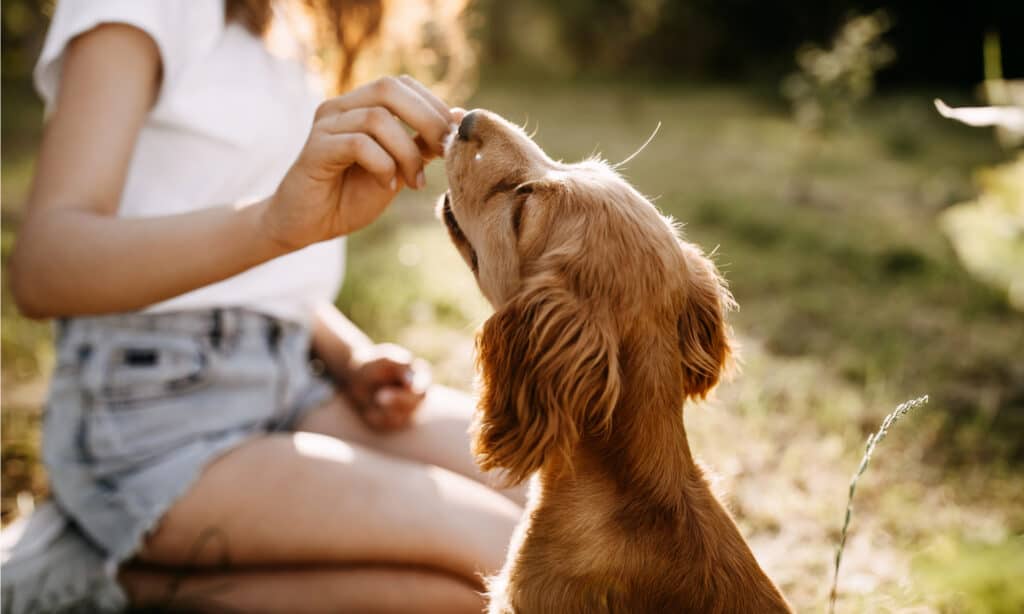Teaching a “sit” cue to your dog is often one of the first skills people teach their puppies. It’s also often the default cue we ask a dog to perform for a treat, when waiting to cross a street, before a door opens, etc. Teaching this cue can be useful, but it can also be quite overused and there are a few instances in which teaching an alternative cue may be better for the health of your dog.
In this guide, we’ll cover a step-by-step of how to ethically ask your dog to sit, as well as provide some reasons why teaching sit as a default cue may not be the best option.
Read on to learn more.
Why Teach a Dog to Sit?
When we talk about teaching a dog to sit, we’re of course referring to teaching a dog to sit on cue. Dogs naturally know how to sit, and some choose to sit naturally more than others. For humans, teaching a sit cue has become a default way of encouraging patience and attentiveness in our pups. Often, asking for a sit is our way of asking our dogs to wait for something or to conform to a human understanding of politeness.
Teaching this cue can be useful, however, there are some important concerns that modern behaviorists and myotherapists are pointing out with the culture of default sit cueing.
Concerns of Default Sit Cueing
For a number of dogs, being asked to sit frequently can actually be quite hard on their joints. Senior dogs, puppies who are still developing, dogs with hip dysplasia, and dogs with certain conformations like greyhounds can have a difficult time with repeated sitting. For these dogs, this repeated motion may exacerbate joint health issues, strain developing bodies, and can cause pain. In some puppy classes, pups are asked to sit up to 30 times per session which may put unnecessary pressure on their bodies during critical growth phases.
Additionally, many people mistakenly believe that asking their dog to sit in a stressful situation results in a calmer dog. However, the opposite may be true. Instead, forcing a sit in these situations may make your pup feel more fearful as dogs seek freedom of movement when they feel unsure or threatened.

Senior dogs may have a hard time moving performing lots of sit-and-stands throughout the day
©Yobab/Shutterstock.com
When Do Dogs Typically Sit Naturally?
For many dogs, sitting often occurs when a dog is observing something, briefly resting, or protecting their genitals during a greeting with another dog. Domesticated dogs may automatically sit when asking for something from their humans because they have been conditioned to do so many times. Dogs in stressful or novel situations tend to prefer to stand so they have increased freedom of movement and the ability to back away, even slightly, from a perceived threat. Most dogs prefer to sniff people and other dogs from a standing position. At extended rest, many dogs prefer to lie down.

You may find that your dog chooses to sit when observing their environment.
©Jay Ondreicka/Shutterstock.com
How to Teach a Dog to Sit
Teaching sits as a constant, default cue is not recommended in this guide. However, you may find this cue useful during some cooperative care tasks, or you may find that your individual dog naturally sits more often and you can shape this behavior into a cue.
Regardless of why you want to teach a sit cue, it’s crucial to only do so using ethical, collaborative methods. If your dog doesn’t want to engage in this behavior, it’s best to try to understand why rather than forcing the issue. Your dog may find being asked to sit repeatedly painful or stressful, or they may not understand the request.
Step-By-Step of How to Teach a Dog to Sit
Below, we’ll detail a step-by-step guide on teaching the sit cue using luring and positive reinforcement. Positive reinforcement uses something the dog finds rewarding to increase the likelihood of a behavior happening again. Luring typically involves using a treat to guide the dog into a desired position. If your dog is showing any signs of fear or discomfort, it’s crucial to stop the process and take a step back, and it’s best to end the session with a treat so they aren’t inadvertently punished for not sitting. For example, you can ask for a cue that they already know and willingly engage in, and then offer a treat.
Steps
It’s important to keep sessions short and fun. The steps to teach a sit cue using luring and positive reinforcement are as follows:
1. With your dog in a standing position, hold a tasty treat about an inch above their head.
2. As they notice the treat and begin to move their head upwards, move the treat back towards their tail.
3. As they follow the treat with their eyes, most dogs will end up sitting.
4. Deliver the treat as their hind end meets the floor.
5. Repeat this process a few times.
6. Once your dog is consistently following the treat, you can begin to raise your hand, still holding the treat between your fingers and thumb, slightly further above the dog’s head to shape your hand cue.
7. Your dog will likely anticipate this hand raising as part of the luring and begin to sit. Immediately praise and deliver a treat.
8. Eventually, once your dog is consistently responding to the hand signal, you can add in the verbal cue “sit”. Dogs learn hand signals much faster than verbal cues, so always start with a hand signal.

You can lure your pup into a sitting position by holding a treat slightly above their head and moving it backwards.
©Natalia Bostan/Shutterstock.com
Alternatives to a Default Sit Cue
As we mentioned above, most folks use a sit cue to communicate a desire for their dog to wait for something or pay attention to them. In light of some concerns around conditioning a sit cue that dogs perform frequently day in and day out, we’ll offer a couple of alternatives. These are the “wait” and “watch me” cues.
Rather than asking for a frequent sit, you can allow your dog to stand or lay down and ask for a wait cue before a door opens, while on leash, before crossing the street, before greeting another dog or person, etc. To best teach this cue, you’ll want to pair it with “ok” to signify a release from the wait. You can teach this skill through the following steps:
- While your dog is in a standing or laying position, face them, raise your hand with your palm out, and calmly say “wait”.
- Wait a couple of seconds and then say “ok” in a cheerful voice and offer them a treat. They should come to you to receive the treat, which helps them understand that “ok” means you are no longer asking them to stay in one position.
- Gradually increase the distance and duration by waiting for longer periods before saying “OK!” and by taking more steps away.
- Start practicing this cue to ask them to wait in a variety of circumstances. This includes while you put the dinner bowl down, before opening a door, crossing the street, meeting a new dog friend, etc.
Teaching “Watch Me”
Watch me is another great cue you can teach your dog that encourages them to check in with you. Many people use a sit cue to try to channel their dog’s attention to them. While this can happen during a sitting position, this can also be achieved with the dog lying down and standing. Thus, if your pup might be at risk of joint stress by sitting frequently, “watch me” can be a great alternative. To teach this cue, use the following steps:
- Call your pup’s name to get their attention and then bring a treat towards your eyes.
- As your dog looks into your eyes or toward your face, praise them and immediately deliver a treat.
- Repeat this a few times.
- Gradually increase the period of time that you hold the treat in front of your eyes before praising and delivering the treat.
- Add the cue “watch me” as you bring the treat to your face.
Of course, some dogs may seem more inclined to sit on their own and without strain. But, if you have a canine companion who might fit into the categories of pups for whom frequently sitting and standing back up can be difficult, these alternatives may be a great option!
The photo featured at the top of this post is © Gajus/Shutterstock.com
Ready to discover the top 10 cutest dog breeds in the entire world?
How about the fastest dogs, the largest dogs and those that are -- quite frankly -- just the kindest dogs on the planet? Each day, AZ Animals sends out lists just like this to our thousands of email subscribers. And the best part? It's FREE. Join today by entering your email below.
Thank you for reading! Have some feedback for us? Contact the AZ Animals editorial team.







